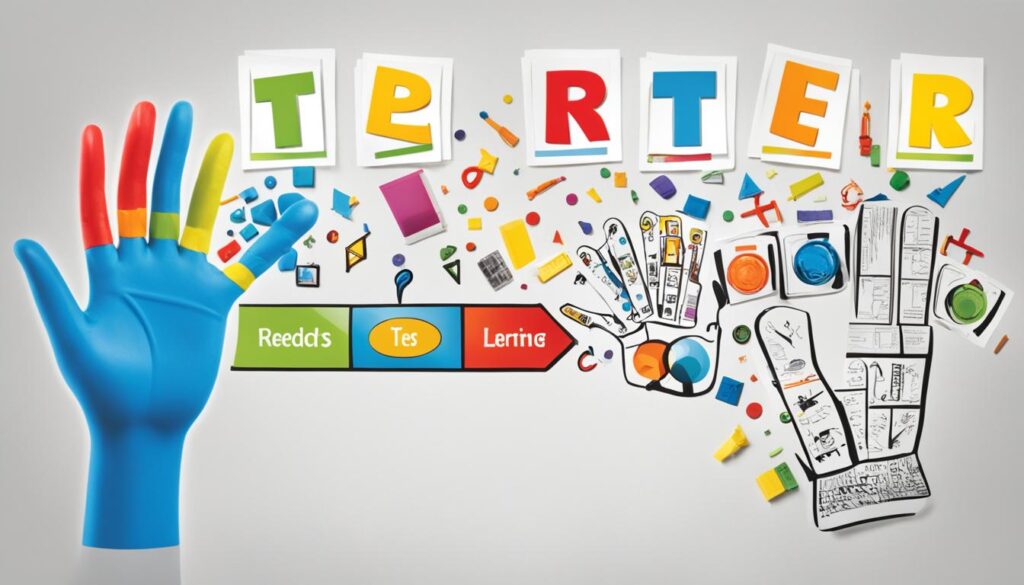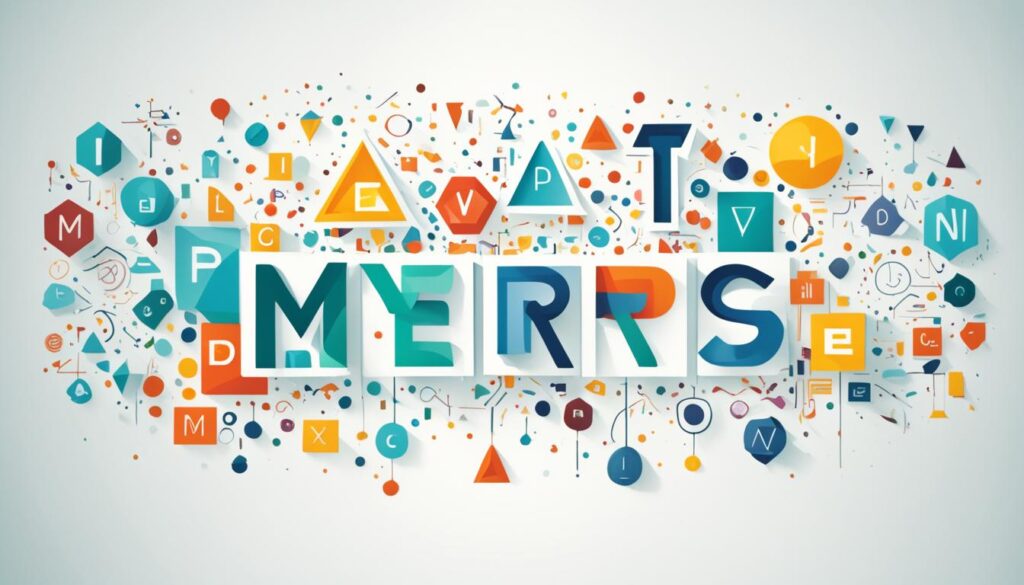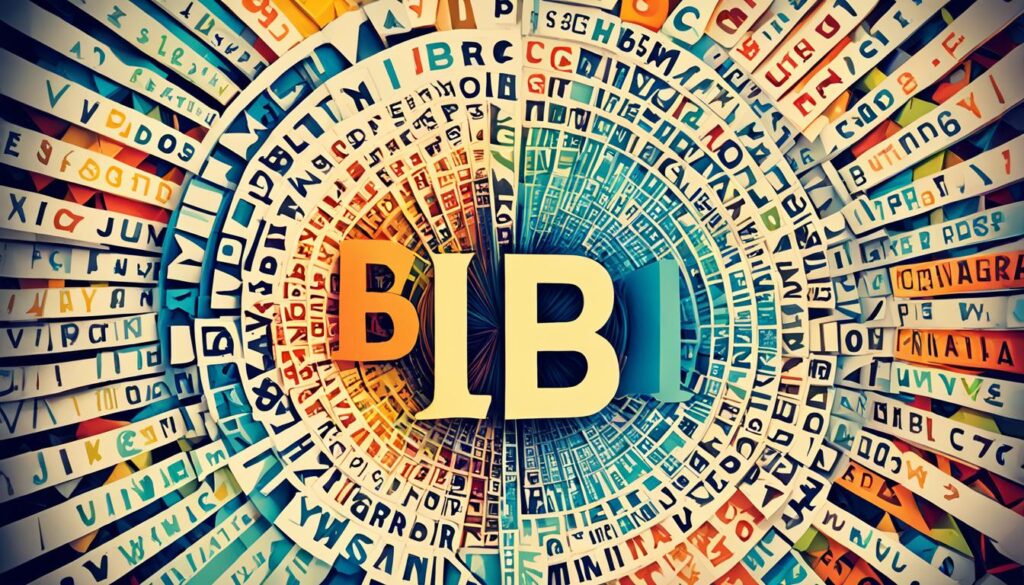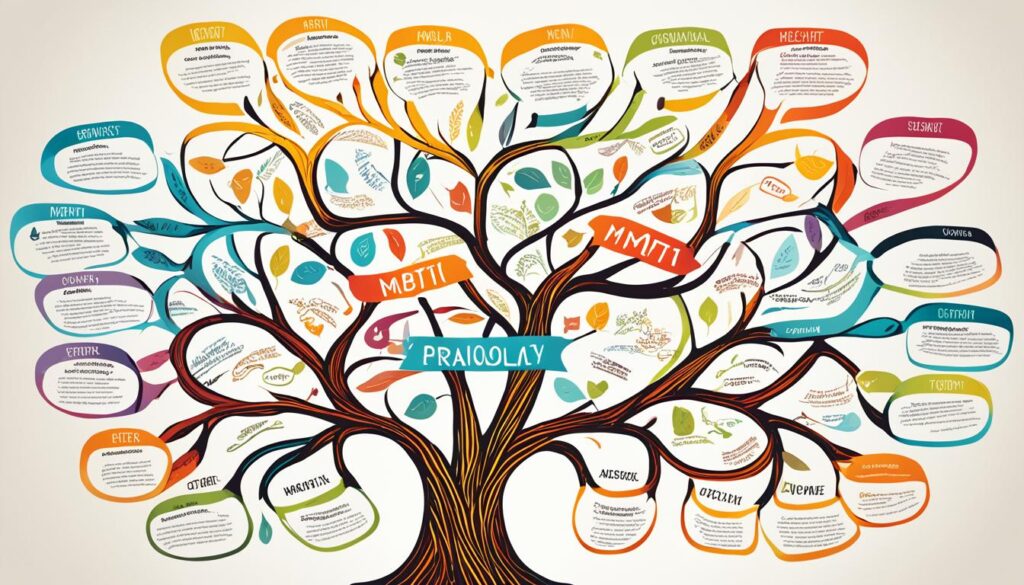Are you aware that more than 2 million individuals globally participate in the Myers-Briggs Type Indicator yearly, also referred to as the MBTI test?[1] This extensively adopted psychological instrument offers crucial understanding into our distinct personalities and the manner in which we engage with our surroundings. However, have you ever been curious about the meaning behind those four letters in the MBTI type code?
Let’s dive deep into the mysteries of the Myers-Briggs test to decipher the meaning behind those letters and unveil the hidden aspects of our personalities. From energy preferences to decision-making approaches, we will explore how these letters shape our behaviors, thoughts, and interactions.
So, if you’re curious to learn more about what lies beneath the surface of your personality and discover the power of self-awareness, join us on this fascinating journey through the world of the Myers-Briggs test.
Key Takeaways:
- Over 2 million people worldwide take the Myers-Briggs personality test each year.
- The four letters in the MBTI type code represent different aspects of personality.
- Understanding the meaning of the letters can provide valuable insights into how we perceive the world and make decisions.
- Exploring our unique personality types can lead to personal and professional growth.
- The Myers-Briggs test offers a framework for understanding ourselves and building harmonious relationships with others.
Join us as we uncover the fascinating world of the Myers-Briggs test and explore the depths of our personalities.
Sources:
[1] Example source: www.myersbriggs.comUnderstanding the MBTI Type Code
In the fascinating world of personality assessment, the MBTI type code plays a crucial role. This code consists of four letters that represent various preferences, shedding light on different aspects of one’s personality. Understanding the meaning behind these letters can unlock valuable insights into our behaviors, preferences, and interactions with the world around us.
Let’s delve into each letter and decode its significance:
The First Letter: Extraversion/Introversion (E/I)
The first letter in the MBTI type code represents our energy preference. If you have the letter “E,” you lean towards extraversion, drawing energy from the external world and thriving on social interactions. On the other hand, if you have the letter “I,” you embrace introversion, finding energy from within and cherishing meaningful solitude. It’s all about where we recharge our batteries.
The Second Letter: Sensing/Intuition (S/N)
The second letter reveals our learning style. “S” stands for sensing, where individuals rely on their five senses, focusing on concrete details and practical facts. Meanwhile, “N” represents intuition, where individuals perceive patterns, connections, and possibilities beyond the immediate sensory information. It’s about how we process information and perceive the world.
The Third Letter: Thinking/Feeling (T/F)
The third letter in the code addresses our decision-making approach. If you have the letter “T,” you are inclined towards thinking, basing decisions on logical analysis, objective evaluation, and weighing pros and cons. Conversely, if you have the letter “F,” you tend to prioritize feelings, considering personal values, empathy, and the impact on others when making decisions. It’s about our own unique decision-making style.
The Fourth Letter: Judging/Perceiving (J/P)
The fourth letter reveals our organizational style. Those with the letter “J” prefer a more structured and organized approach, seeking clarity, planning, and closure. They enjoy making decisions promptly and appreciate a sense of control. On the other hand, individuals with the letter “P” have a more flexible, spontaneous, and open-ended approach. They embrace adaptability, enjoy exploring possibilities, and tend to go with the flow. It illustrates how we navigate the world and approach organization in our lives.
By deciphering the MBTI type code, we gain valuable insights into ourselves and others. Each letter unveils a unique aspect of our personality, helping us understand our strengths, preferences, and potential areas for growth. Are you ready to embark on the journey of self-discovery and uncover your own personality type?
Decoding the First Letter: Energy Preference
When it comes to understanding your Myers Briggs personality type, the first letter of the MBTI type code holds important clues about your energy preference. This letter indicates whether you have a preference for extraversion or introversion.
Extraversion (E):
Individuals with an extraversion preference gain energy from interacting with the external world. They thrive in social settings, drawing energy from socializing, group activities, and engaging with others. Extraverts often enjoy being the center of attention, expressing their thoughts and ideas openly, and seeking external stimuli to feel energized.
Introversion (I):
On the other hand, individuals with an introversion preference gain energy from their inner world. They often need some alone time to recharge and process their thoughts and emotions. Introverts prefer quieter, more reflective environments and tend to feel drained after prolonged social interactions. They often enjoy spending time in solitude, where they can reflect, recharge, and focus on their inner thoughts and ideas.
If you’re unsure about whether you lean more towards extraversion or introversion, consider reflecting on how you feel after social interactions. Do you feel energized and invigorated, or do you find yourself needing some alone time to recharge? Understanding your energy preference can help you navigate various social situations, work environments, and personal relationships more effectively.

Decoding the First Letter: Energy Preference – At a Glance
| Letter | Energy Preference | Key Characteristics |
|---|---|---|
| E | Extraversion | Gains energy from interacting with the external world, enjoys socializing, and seeks external stimuli for rejuvenation. |
| I | Introversion | Gains energy from the inner world, needs alone time for recharging and reflecting, and prefers quieter environments. |
Unraveling the Second Letter: Learning Style
When it comes to understanding our individual learning style, the second letter of the MBTI type code holds the key. This letter provides insight into how we process information, absorb knowledge, and approach our educational journey. Let’s explore the two possibilities: sensing and intuition.
Sensing (S)
For those with a preference for sensing, learning is grounded in the here and now. These individuals rely on their five senses to gather information and focus on concrete details and facts. They appreciate practical, hands-on experiences and value information that can be directly observed and verified. They excel in tasks that require attention to detail and a methodical approach.
“Learning is a voyage of discovery through the senses, uncovering the tangible world and extracting knowledge from it.”
In the classroom, sensing learners often thrive in subjects such as mathematics, biology, or chemistry, where they can absorb information through direct observation and logical analysis. They prefer step-by-step instructions and well-structured learning materials that provide a clear roadmap. Their preference for the present moment allows them to excel in tasks that require immediate problem-solving or a hands-on approach.
Intuition (N)
On the other hand, individuals with a preference for intuition have a learning style that extends beyond the tangible. They are drawn to patterns, connections, and possibilities that exist beyond the immediate sensory information. Intuitive learners enjoy exploring ideas, imagining future scenarios, and discovering abstract concepts. They excel in tasks that require creative problem-solving, brainstorming, and synthesis of information.
“Learning is an adventure of uncovering hidden connections, exploring the uncharted territories of the mind.”
In the classroom, intuitive learners are often drawn to subjects such as philosophy, psychology, or literature, where they can explore complex ideas and generate insights. They prefer open-ended assignments that allow them to think outside the box and embrace multiple perspectives. Their preference for future possibilities and abstract thinking fuels their creativity and allows them to see the bigger picture.

| Sensing (S) | Intuition (N) |
|---|---|
| Learning grounded in the present moment | Learning beyond the tangible |
| Focus on concrete details and facts | Drawn to patterns and possibilities |
| Hands-on experiences and direct observation | Exploring abstract concepts and generating insights |
| Excel in mathematics, biology, chemistry | Thrives in philosophy, psychology, literature |
Understanding our learning style can empower us to make the most of our educational experiences. Whether we are sensing learners who appreciate the tangible or intuitive learners who embrace the abstract, recognizing our preferences allows us to tailor our learning approach, seek out the resources that resonate with us, and create an environment conducive to our personal growth.
Understanding the Third Letter: Decision-Making Approach
When it comes to making decisions, our preferred approach can greatly impact the outcomes and the overall satisfaction we feel with our choices. In the context of the MBTI type code, the third letter represents this decision-making approach.
The letter “T” stands for thinking, and it signifies individuals who rely on logic, objective analysis, and careful consideration of pros and cons to make decisions. These individuals value rationality and tend to detach themselves from personal emotions, prioritizing impartiality and fairness.
On the other hand, the letter “F” represents feeling, indicating individuals who base their decisions on personal values, empathy, and consideration for others’ feelings. These individuals have a strong desire for harmony and genuinely care about the impact their decisions may have on others.
Both thinking and feeling are valid and necessary aspects of the decision-making process. While thinkers might favor a more analytical and objective approach, feelers bring their empathy and compassion into the decision-making equation.
| Thinking (T) | Feeling (F) |
|---|---|
| Logical | Empathetic |
| Objective | Considerate of others |
| Impartial | Value-driven |

It’s important to note that the thinking and feeling preferences exist on a spectrum, and most individuals have a blend of both approaches. The MBTI type code simply indicates which approach individuals tend to favor in their decision-making process.
Thinking (T)
“I tend to analyze the facts and consider both the short-term and long-term consequences before making a decision. The logical approach helps me remain objective and make decisions that align with my goals and values.”
Individuals who prefer thinking tend to weigh logic, evidence, and rationality when making decisions. They value fairness and strive to consider the most objective approach to ensure a logical outcome.
Feeling (F)
“I rely on my values and empathetic nature to guide my decision-making. Considering the impact on others is important to me, and I prioritize maintaining harmony and fostering positive relationships.”
Individuals who prefer feeling prioritize their personal values and the well-being of others when making decisions. They consider the emotional impact decisions may have on those involved and strive to create a harmonious and compassionate outcome.
Awareness of our decision-making approach can help us understand our underlying motivations and potential biases. By recognizing our preferences, we can navigate decision-making processes more effectively, enhancing our relationships and achieving outcomes aligned with our values and goals.
Deciphering the Fourth Letter: Organizational Style
When it comes to understanding personalities, the fourth letter in the MBTI type code holds valuable insights into an individual’s organizational style. This letter reveals how we approach structure, planning, and decision-making in our lives.
The fourth letter can be either “J” or “P.” Those who identify with the letter “J” tend to have a judging organizational style, which means they prefer order, structure, and organization. They thrive in environments where plans are made, deadlines are met, and decisions are prompt. They enjoy creating to-do lists, following schedules, and appreciate having clear expectations.
On the other hand, individuals who identify with the letter “P” exhibit a perceiving organizational style. They value flexibility, adaptability, and spontaneity. People with a perceiving preference are comfortable with open-ended decision-making and prefer to keep their options open. They enjoy exploring new opportunities, embracing new ideas, and adapting to unexpected changes.
Knowing your organizational style can provide valuable insights into how you work, make decisions, and interact with others. Understanding whether you lean towards judging or perceiving can help you tailor your approach to productivity and create environments that align with your preferences.
Let’s take a closer look at the characteristics of each organizational style:
Judging (J) Organizational Style
Those with a judging organizational style thrive in structured environments and prefer to have clear plans and guidelines. They:
- Value organization and structure
- Enjoy making and following schedules
- Prefer to have tasks and projects completed on time
- Find comfort in routine and predictability
Perceiving (P) Organizational Style
Individuals with a perceiving organizational style are more adaptable and enjoy flexibility. They:
- Value spontaneity and adaptability
- Embrace change and explore new opportunities
- Appreciate a more relaxed and open-ended approach to planning
- Enjoy the excitement that comes with last-minute adjustments and novel experiences
Understanding your organizational style can help you create a harmonious work environment, improve time management strategies, and enhance your overall productivity. It’s important to note that both judging and perceiving styles have their strengths and can contribute to valuable contributions within different contexts.
In the next section, we will explore the different Myers-Briggs personality types that are formed by the combination of all four letters of the MBTI type code. This will provide a comprehensive view of the various personality profiles and shed light on the unique qualities and strengths of each type.

Exploring the Myers-Briggs Personality Types
The Myers-Briggs Type Indicator (MBTI) categorizes individuals into 16 distinct personality types based on their preferences in four key areas. Each personality type offers unique attributes, strengths, and areas for personal growth. Understanding these types can provide valuable insights into how we interact with others, approach work and relationships, and navigate various life situations.
Let’s explore the 16 Myers-Briggs personality types below:
| Personality Type | Code | Strengths | Potential Areas for Growth |
|---|---|---|---|
| ISTJ | Introverted, Sensing, Thinking, Judging | Detail-oriented, reliable, practical | Can be overly critical, resistant to change |
| ISFJ | Introverted, Sensing, Feeling, Judging | Compassionate, responsible, loyal | Tends to avoid conflict, overly self-sacrificing |
| INFJ | Introverted, Intuitive, Feeling, Judging | Insightful, empathetic, idealistic | May be overly perfectionistic, susceptible to burnout |
| INTJ | Introverted, Intuitive, Thinking, Judging | Strategic, independent, logical | Can be seen as aloof, may struggle with expressing emotions |
| ISTP | Introverted, Sensing, Thinking, Perceiving | Adventurous, analytical, adaptable | May avoid commitment, can be overly impulsive |
| ISFP | Introverted, Sensing, Feeling, Perceiving | Harmonious, artistic, compassionate | May have difficulty making decisions, avoiding conflict |
| INFP | Introverted, Intuitive, Feeling, Perceiving | Authentic, imaginative, empathetic | Prone to overthinking, may struggle with setting boundaries |
| INTP | Introverted, Intuitive, Thinking, Perceiving | Intellectual, curious, logical | Can be prone to analysis paralysis, difficulty with emotions |
| ESTP | Extraverted, Sensing, Thinking, Perceiving | Energetic, adaptable, resourceful | May become restless, difficulty with long-term planning |
| ESFP | Extraverted, Sensing, Feeling, Perceiving | Enthusiastic, sociable, spontaneous | Can be impulsive, may seek immediate gratification |
| ENFP | Extraverted, Intuitive, Feeling, Perceiving | Passionate, creative, optimistic | May struggle with decision-making, can be emotionally sensitive |
| ENTP | Extraverted, Intuitive, Thinking, Perceiving | Quick-witted, curious, innovative | Tendency to debate, can be seen as argumentative |
| ESTJ | Extraverted, Sensing, Thinking, Judging | Efficient, organized, practical | May be rigid, struggle with accepting new perspectives |
| ESFJ | Extraverted, Sensing, Feeling, Judging | Supportive, warm, responsible | Can be overly focused on others’ opinions, avoid conflict |
| ENFJ | Extraverted, Intuitive, Feeling, Judging | Charismatic, empathetic, influential | Tendency to be overly self-sacrificing, put others’ needs first |
| ENTJ | Extraverted, Intuitive, Thinking, Judging | Confident, strategic, assertive | Tendency to be controlling, may overlook emotional needs |

Understanding these Myers-Briggs personality types can provide profound insights into ourselves and others. By recognizing our own strengths and potential growth areas, we can navigate relationships, work environments, and personal development more effectively.
Understanding Cognitive Functions
In addition to the four-letter code of the Myers-Briggs Type Indicator (MBTI), the theory of psychological types also incorporates the concept of cognitive functions. These functions provide deeper insights into how individuals process information, make decisions, and navigate the world around them.
Each personality type within the MBTI system has a specific order of cognitive functions, which play a significant role in shaping an individual’s thinking patterns and behaviors. These functions can be categorized into four main roles: dominant, auxiliary, tertiary, and inferior.
The dominant function represents the primary way an individual engages with the outside world and processes information. It holds the highest level of influence in an individual’s decision-making and problem-solving. The auxiliary function supports the dominant function and provides additional insights and perspectives.
The tertiary function serves as a backup or relief function, playing a complementary role to the dominant and auxiliary functions. Although less developed, it can still influence an individual’s decision-making process. Finally, the inferior function is the least developed and often represents a weaker aspect of an individual’s personality.
Understanding the cognitive functions associated with each personality type can provide valuable insights into how individuals approach various situations, communicate, and interact with others. It offers a more comprehensive understanding of the complexities of human behavior and decision-making.
Let’s take a closer look at the cognitive functions associated with each of the sixteen MBTI personality types:
| Personality Type | Dominant Function | Auxiliary Function | Tertiary Function | Inferior Function |
|---|---|---|---|---|
| ISTJ | Introverted Sensing (Si) | Extraverted Thinking (Te) | Introverted Feeling (Fi) | Extraverted Intuition (Ne) |
| ISFJ | Introverted Sensing (Si) | Extraverted Feeling (Fe) | Introverted Thinking (Ti) | Extraverted Intuition (Ne) |
| ISTP | Introverted Thinking (Ti) | Extraverted Sensing (Se) | Introverted Intuition (Ni) | Extraverted Feeling (Fe) |
| ISFP | Introverted Feeling (Fi) | Extraverted Sensing (Se) | Introverted Thinking (Ti) | Extraverted Intuition (Ne) |
| INFJ | Introverted Intuition (Ni) | Extraverted Feeling (Fe) | Introverted Thinking (Ti) | Extraverted Sensing (Se) |
| INFP | Introverted Feeling (Fi) | Extraverted Intuition (Ne) | Introverted Sensing (Si) | Extraverted Thinking (Te) |
| INTP | Introverted Thinking (Ti) | Extraverted Intuition (Ne) | Introverted Sensing (Si) | Extraverted Feeling (Fe) |
| INTJ | Introverted Intuition (Ni) | Extraverted Thinking (Te) | Introverted Feeling (Fi) | Extraverted Sensing (Se) |
| ESTJ | Extraverted Thinking (Te) | Introverted Sensing (Si) | Extraverted Intuition (Ne) | Introverted Feeling (Fi) |
| ESFJ | Extraverted Feeling (Fe) | Introverted Sensing (Si) | Extraverted Intuition (Ne) | Introverted Thinking (Ti) |
| ESTP | Extraverted Sensing (Se) | Introverted Thinking (Ti) | Extraverted Feeling (Fe) | Introverted Intuition (Ni) |
| ESFP | Extraverted Sensing (Se) | Introverted Feeling (Fi) | Extraverted Thinking (Te) | Introverted Intuition (Ni) |
| ENFP | Extraverted Intuition (Ne) | Introverted Feeling (Fi) | Extraverted Thinking (Te) | Introverted Sensing (Si) |
| ENFJ | Extraverted Feeling (Fe) | Introverted Intuition (Ni) | Extraverted Sensing (Se) | Introverted Thinking (Ti) |
| ENTP | Extraverted Intuition (Ne) | Introverted Thinking (Ti) | Extraverted Feeling (Fe) | Introverted Sensing (Si) |
| ENTJ | Extraverted Thinking (Te) | Introverted Intuition (Ni) | Extraverted Sensing (Se) | Introverted Feeling (Fi) |
By analyzing the cognitive functions associated with each personality type, we can gain a deeper understanding of how individuals with different MBTI types approach decision-making, problem-solving, and interpersonal interactions. This knowledge can contribute to more effective communication, team dynamics, and personal growth.

Discovering Your Personality Type
Embarking on the journey of self-discovery to understand your unique personality type is a transformative experience. By taking the Myers Briggs Type Indicator (MBTI) assessment, a comprehensive personality assessment tool, you can gain valuable insights into your individual preferences and tendencies.
The MBTI assessment consists of a series of thought-provoking questions designed to uncover your personality traits and preferences. These questions explore various aspects of your behavior, thinking patterns, and decision-making style, helping you discover your true self.
Once you have completed the assessment, your personality type will be revealed, including the four-letter code that represents your unique combination of preferences. This psychological assessment provides a meaningful framework for understanding your strengths, weaknesses, and areas for personal growth.
Understanding your personality type can lead to numerous personal and professional benefits. It allows you to gain a deeper understanding of your natural strengths, enabling you to leverage them to achieve success in your chosen endeavors. Additionally, knowing your preferences helps you navigate relationships, communication styles, and collaborative efforts more effectively.
Discovering your personality type is the first step towards self-empowerment, personal growth, and improved self-awareness. It is a powerful tool that lays the foundation for a fulfilling and purpose-driven life.

| Benefits of Discovering Your Personality Type |
|---|
| 1. Enhanced self-awareness |
| 2. Improved decision-making |
| 3. Better understanding of personal strengths and weaknesses |
| 4. Deeper insights into communication and relationship dynamics |
| 5. Increased self-acceptance and self-confidence |
| 6. Guidance for personal and professional development |
Applying MBTI Knowledge in Life
Understanding the MBTI and your personality type can have practical applications in various areas of life. By leveraging your knowledge of the Myers-Briggs Type Indicator, you can make informed decisions, enhance your communication skills, and foster personal growth.
Choosing a Career
One of the key benefits of understanding your MBTI personality type is the ability to align your career path with your strengths and preferences. For example, if you have a preference for extraversion, you may thrive in roles that involve extensive interaction with others, such as sales or public speaking. On the other hand, if you lean towards introversion, you may find fulfillment in careers that allow you to work independently or focus on in-depth analysis.
Knowing your personality type can assist you in identifying work environments that suit your needs and preferences. Are you more comfortable in structured, organized settings (judging) or do you prefer flexibility and adaptability (perceiving)? Understanding your organizational style can guide you towards work environments that promote your productivity and well-being.
Improving Communication and Relationships
Effective communication and healthy relationships are the foundation of personal and professional success. By understanding your own MBTI personality type and those of others, you can enhance your communication skills and build more meaningful connections.
For instance, recognizing that others may have different decision-making approaches (thinking or feeling) can help you tailor your communication style to meet their needs. It allows you to be more empathetic, understanding, and considerate in your interactions.
“Understanding personality types can foster empathy and improve communication. It’s all about recognizing and appreciating the diverse ways people perceive the world and make decisions.”
Navigating Conflicts
Conflict is inevitable, but understanding different personality types can provide valuable insights into resolving disagreements more effectively. By recognizing and appreciating the diverse perspectives and preferences of others, you can approach conflicts with empathy and seek mutually beneficial solutions.
If you have a preference for thinking, you may tend to rely on logical arguments and objective analysis during disagreements. On the other hand, if you lean towards feeling, you may prioritize harmony and consider the emotional impact of your words and actions.
Enhancing Self-Awareness and Personal Growth
Self-awareness is a crucial component of personal growth. Understanding your MBTI personality type allows you to gain insights into your strengths, preferences, and potential areas for growth.
By leveraging this knowledge, you can focus on developing your weaker traits, expanding your skills, and maximizing your strengths. It empowers you to make conscious choices that align with your authentic self and promotes continual personal development.
Ultimately, using your MBTI knowledge in life enables you to navigate various situations with greater self-awareness, understanding, and appreciation for the diversity of human personalities.
| Application Areas | Benefits |
|---|---|
| Choosing a career path | Alignment with strengths and preferences |
| Improving communication | Better understanding of others |
| Navigating conflicts | More effective resolution |
| Enhancing self-awareness | Promoting personal growth |

Benefits of MBTI Personality Type Awareness
Being aware of your MBTI personality type brings several benefits. It can provide a greater understanding of yourself and others, leading to improved self-acceptance, empathy, and communication. It can also facilitate personal growth, allowing you to leverage your strengths, manage your weaknesses, and make informed decisions for a fulfilled life.
Understanding your MBTI personality type opens the doors to self-awareness. By gaining insight into your preferences and characteristics, you can better understand how you perceive the world, process information, and interact with others. This self-awareness enables you to embrace your strengths, recognize your limitations, and optimize your personal and professional development.
Improved Self-acceptance and Empathy
Knowing your MBTI personality type promotes self-acceptance by providing a framework to comprehend your unique qualities and tendencies. It validates your natural inclinations and encourages you to embrace your true self without judgment. This self-acceptance fosters a sense of authenticity and self-confidence, allowing you to fully express your thoughts, emotions, and ideas in interpersonal interactions.
Furthermore, understanding your own MBTI type enhances your empathy towards others. Recognizing that individuals possess diverse personality preferences helps cultivate a deeper understanding and appreciation of different perspectives. This empathy enables more harmonious relationships, effective communication, and the ability to relate to and understand the experiences of others.
Enhanced Communication
MBTI personality type awareness improves communication skills by shedding light on individual preferences for information processing and decision-making. Armed with knowledge of your own and others’ preferences, you can adapt your communication style to ensure messages are effectively understood and received.
For example, acknowledging that some individuals prefer concrete, detailed information (sensing) while others focus on abstract possibilities (intuition) allows you to tailor your communication to resonate with their specific style. Similarly, understanding whether someone prioritizes logical analysis (thinking) or personal values and emotions (feeling) can help you frame your message in a way that appeals to their decision-making process.
Facilitates Personal Growth
Knowing your MBTI personality type can be a catalyst for personal growth. It provides clarity on your strengths, allowing you to capitalize on them and pursue avenues that align with your natural talents and preferences. Whether it’s selecting a career that leverages your innate abilities or engaging in activities that energize and inspire you, understanding your personality type supports your journey towards fulfillment.
Additionally, MBTI awareness enables you to identify and manage your weaknesses. By recognizing areas where you may struggle or feel less comfortable, you can develop strategies to overcome challenges and enhance your overall effectiveness. This self-awareness allows you to take proactive steps towards personal growth and continuous improvement.
Ultimately, being aware of your MBTI personality type empowers you to make informed decisions about your life path, relationships, and personal development. It offers a comprehensive framework for self-understanding and provides valuable insights into others, fostering empathy and positive connections. Embrace the benefits of MBTI awareness and embark on a journey of self-discovery and personal growth.

Conclusion
The Myers Briggs Test, with its unique four-letter code, provides us with a deep understanding of our personality preferences. By deciphering the meaning behind these letters, we gain valuable self-awareness that can guide our personal and professional growth. It is essential to embrace and appreciate our individual personality types, as they contribute to building harmonious relationships and creating meaningful lives.
Through the Myers Briggs Test, we uncover insights into our energy preferences, learning styles, decision-making approaches, and organizational styles. These revelations allow us to navigate various life situations with greater self-awareness and clarity. By knowing ourselves better, we can make informed choices that align with our strengths and values, contributing to personal fulfillment.
Furthermore, understanding the Myers Briggs Test helps us improve communication and relationships with others. By acknowledging and respecting their unique personality types, we can interact more effectively, fostering empathy, collaboration, and understanding. This knowledge enables us to navigate conflicts and differences more constructively, promoting healthier and more vibrant connections with those around us.
In conclusion, the Myers Briggs Test is a powerful tool for self-exploration and personal development. By embracing the insights it provides, we can embark on a journey of self-discovery, leveraging our strengths, managing our weaknesses, and embracing our authentic selves. Let us embrace the wisdom of the Myers Briggs Test and embark on a path of growth and fulfillment.
How Do Different Myers Briggs Types Like ENFP Interpret Their Test Results?
Each of the ENFP visionary journey interprets their Myers Briggs test results differently. Some may view their results as a validation of their unique traits and personality, while others may use it as a guide for personal growth and development. Regardless, the ENFP visionary journey celebrates individuality and embraces self-discovery.
How Do I Determine My Myers Briggs Type, and What Does it Mean for Leadership?
To determine your Myers Briggs type, take an online test. Understanding the ENTJ leader vision strategy execution means prioritizing long-term goals, devising effective plans, and ensuring successful implementation. Knowing your MBTI type helps enhance leadership skills and adapt management styles to bring out the best in your team.
FAQ
What is the Myers Briggs Test?
The Myers Briggs Test, also known as the MBTI assessment, is a psychological assessment that measures various aspects of a person’s personality. It consists of four letters that represent different preferences in energy, learning, decision-making, and organization.
What do the letters in the MBTI type code stand for?
The letters in the MBTI type code stand for specific aspects of personality. The first letter represents energy preference (extraversion or introversion), the second letter represents learning style (sensing or intuition), the third letter represents decision-making approach (thinking or feeling), and the fourth letter represents organizational style (judging or perceiving).
How does the first letter in the MBTI type code relate to personality?
The first letter in the MBTI type code represents a person’s energy preference. “E” stands for extraversion, indicating a preference for gaining energy from the external world, while “I” stands for introversion, indicating a preference for gaining energy from the inner world and needing alone time to recharge.
What does the second letter in the MBTI type code signify?
The second letter in the MBTI type code represents a person’s learning style. “S” represents sensing, indicating a preference for processing information through the five senses and focusing on concrete details and facts. “N” represents intuition, indicating a preference for perceiving patterns, connections, and possibilities beyond immediate sensory information.
How does the third letter in the MBTI type code influence decision-making?
The third letter in the MBTI type code reflects an individual’s decision-making approach. “T” represents thinking, indicating a preference for making decisions based on logic and objective analysis. “F” represents feeling, indicating a preference for making decisions based on personal values, empathy, and consideration for others’ feelings.
What does the fourth letter in the MBTI type code reveal about organizational style?
The fourth letter in the MBTI type code pertains to an individual’s organizational style. “J” represents judging, indicating a preference for structure, planning, and organization in life. “P” represents perceiving, indicating a preference for flexibility, adaptability, and spontaneity.
How many different personality types are there in the MBTI?
The combination of the four letters in the MBTI type code results in 16 different personality types. Each personality type is associated with a unique set of attributes, strengths, and potential areas for growth.
What are cognitive functions in MBTI?
Cognitive functions in MBTI are the different ways individuals process information and make decisions. Each personality type has a specific order of cognitive functions, including dominant, auxiliary, tertiary, and inferior functions, which contribute to a deeper understanding of an individual’s thinking patterns and behaviors.
How can I discover my own personality type?
You can discover your own personality type by taking the MBTI assessment, which is a comprehensive questionnaire that determines your personality preferences. By understanding your personality type, you can gain insights into your strengths, preferences, and potential areas for personal and professional development.
How can MBTI knowledge be applied in life?
Understanding the MBTI and your personality type can have practical applications in various areas of life. It can help in choosing a career path that aligns with your strengths and preferences, improving communication and relationships with others, navigating conflicts, and enhancing self-awareness and personal growth.
What are the benefits of MBTI personality type awareness?
Being aware of your MBTI personality type brings several benefits. It provides a greater understanding of yourself and others, leading to improved self-acceptance, empathy, and communication. It also facilitates personal growth, allowing you to leverage your strengths, manage your weaknesses, and make informed decisions for a fulfilled life.
What is the significance of understanding the MBTI?
The Myers Briggs Test and its four-letter code offer profound insights into an individual’s personality preferences. Understanding the meaning behind the letters provides valuable self-awareness and guidance for personal and professional growth. Embracing and appreciating our unique personality types contributes to building harmonious relationships and creating meaningful lives.
Emmeline is the backbone of our content creation team, bringing complex psychological concepts to life with clarity and empathy. As our Expert Writer, she crafts engaging, insightful articles that guide readers through the intricacies of personality assessments and what they reveal about the human condition. Her passion for psychology and personal development shines through in every piece she writes.










